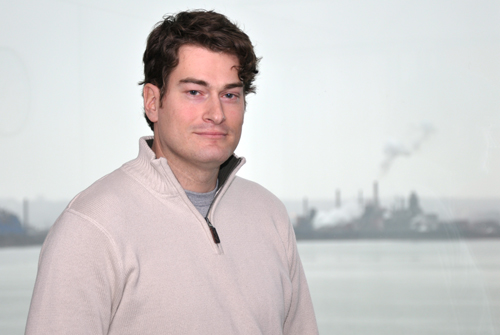
Stephen Hill’s office overlooks Lake Ontario, a fitting view for someone who studies water quality. As a molecular microbiology technologist at the Canada Centre for Inland Waters (CCIW) in Burlington, Ont., he analyzes E. coli found in lakes and rivers to determine the origin of the bacteria. The presence of E. coli in water is a sign of contamination from human or animal waste.
“This all fits into the context of our research on water-borne pathogens,” says Hill, M.Sc. ’12. “As an environmental biologist, I really want to see what’s going on with all these bugs in the environment – who survives in the water, who survives treatment, how they get disseminated and, ultimately, what risk that poses to humans and the ecosystem.” E. coli is normally found in the intestinal tract. Pathogenic strains such as E. coli O157:H7 that contaminated the water supply in Walkerton, Ont., in 2000 can cause severe illness and death. Other forms of transmission include improper hand washing and eating undercooked meat.
“We wanted to take a look at some of those different fecal sources – sewage, wildlife and agriculture – that might contaminate the water and see what different kinds of E. coli pathogens were in it,” says Hill. Genetic markers in the bacteria can identify the type of host it came from. Using microarrays in the lab, Hill can identify hundreds of genes in bacterial samples. Tiny spots of DNA containing disease-causing virulence genes are printed on a glass slide and compared to the DNA of E. coli found in water samples.
High levels of E. coli often force beaches to close in the summer, but the source of contamination can vary from sewage to seagulls. “E. coli is normal to find in the water,” says Hill, adding that bird sources are less likely to contain E. coli pathogens than sewage. In the sewage samples he studied, as much as 20 per cent of the E. coli he isolated were pathogenic strains, mainly those causing urinary tract infections. “That’s a lot,” says Hill. “What risk it presents by finding it at such high numbers – surviving treatment through sewage and being released to the water – is a bit of an unknown right now.”
Sewage contamination can be reduced – but not eliminated – through waste-water treatment methods such as chlorination, but no treatment method is perfect. “In most cases something will get through,” says Hill. “I would say it’s normal to find some levels of bacteria after treatment. What’s interesting is how much of this E. coli pathogen we found that is also surviving treatment.”
The fight against bacteria is complicated by the fact that they’re constantly evolving to ensure their survival. E. coli bacteria are known to swap genes, resulting in new strains. Their ability to adapt to their environment also plays a role in developing antibiotic resistance. “As we use so many antibiotics for our own health and agriculture, the bacteria are developing resistance,” says Hill. “Quite a lot of the E. coli we researched had multiple antibiotic resistance, particularly from human sources. It’s an emerging concern that we’re finding it so readily in the environment, both because of the capacity of bacteria to swap genes and the risk to us.”
Hill did his undergrad in cellular and molecular biology at the University of Toronto, where he studied the use of microbes to clean up industrial land. He started working at the CCIW as an intern about 10 years ago and was later offered a full-time position. He also wanted to pursue a master’s degree while working, so he came to U of G to study part-time with Prof. Jack Trevors in the School of Environmental Sciences. Hill successfully defended his thesis on “Virulence Factors in Fecal Escherichia coli from Humans and Animals” last December. The research was funded by Environment Canada.